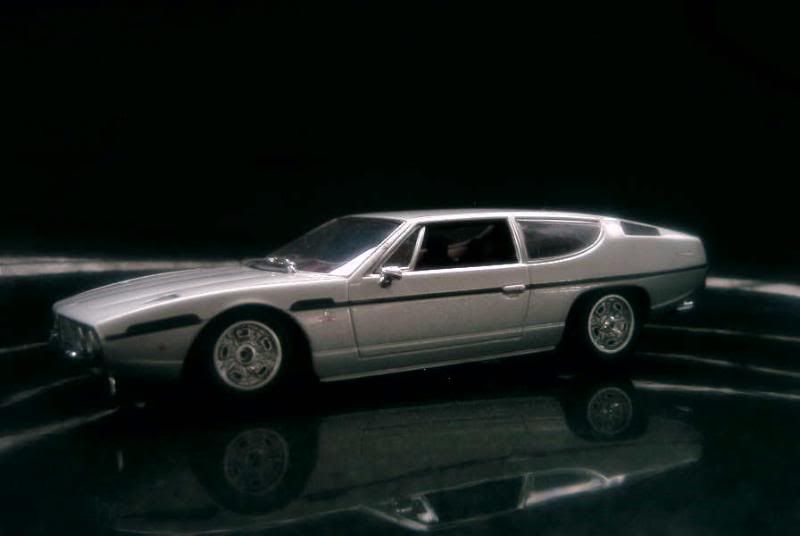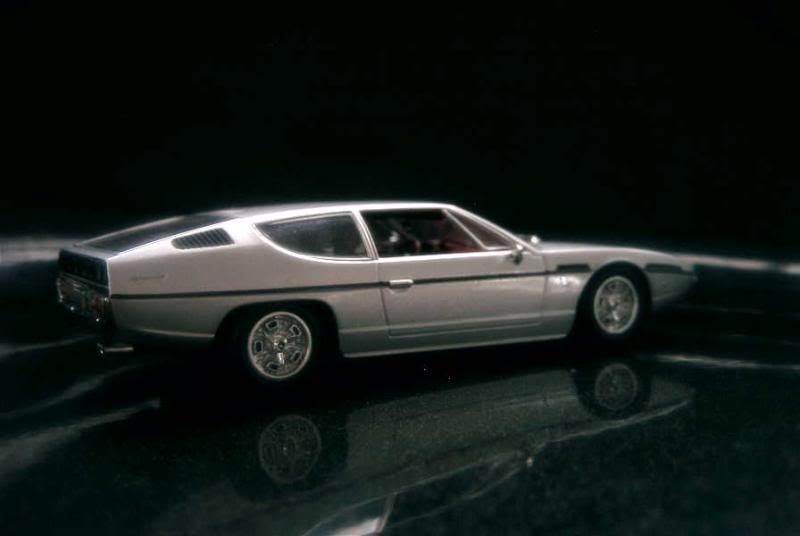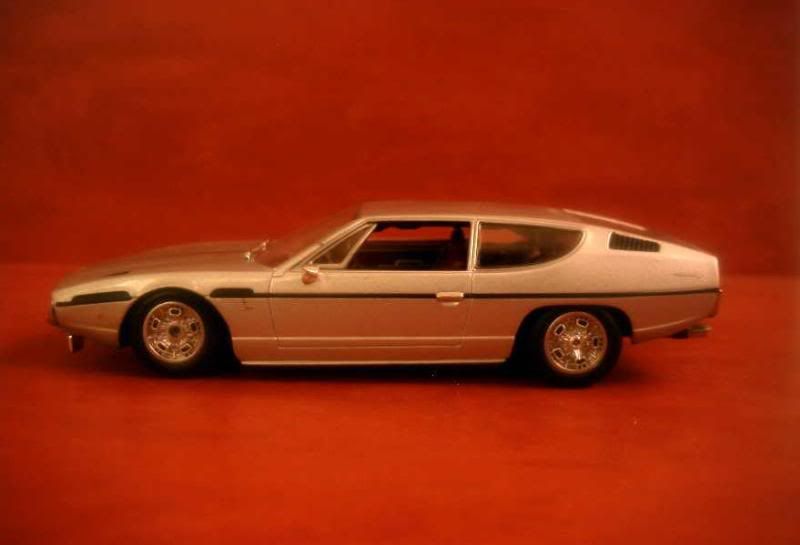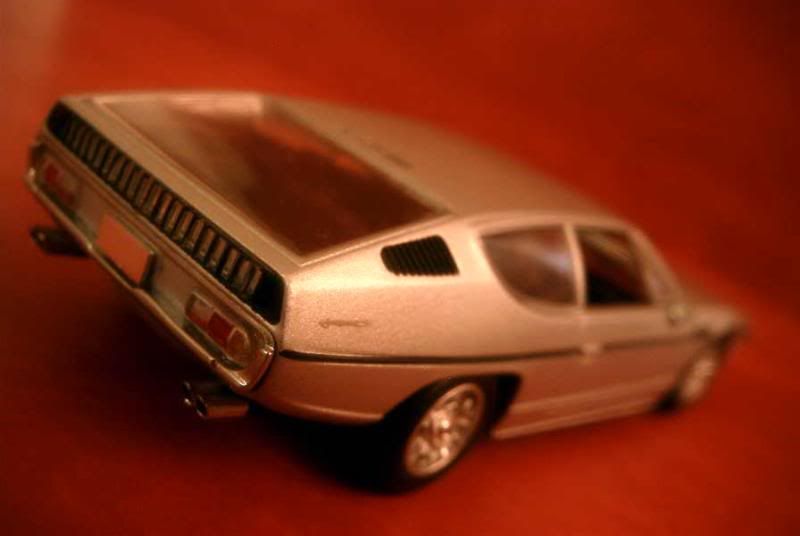A little history
Thanks to its extraordinary 350/400GT and Miura coupes, Lamborghini, a newcomer on the Sixties supercars scene, enjoyed a large share of limelight from the very start. The aforementioned models being, respectively, a 2+2 and a strict two-seater, the Sant’Agata factory decided its next model would be a true four-seater, promising comfort at high speeds over long distances.
Lamborghini’s plans first materialized as the Marzal prototype, unveiled at the Geneva motor show in March 1967. Collaboration with Bertone was retained, so the Marzal was again signed by Marcello Gandini, though the flowing lines of its Miura gave way to the angular style that would be the trademark of this design studio for many years to come. Nonetheless this brutal helm tilting, the Marzal’s appearance was again impressive, featuring low, long lines and characteristically immense glazed area – the gullwing doors were almost entirely made of window panes, including in their lower parts. Another striking trait of the Marzal was its loophole-styled grille encompassing six tiny headlights. After Geneva, Lamborghini tested the public’s reaction even further by lending its prototype, which was fully functional, as a pace car for the Monaco Grand Prix.
The production version of the Marzal was unveiled one year later, almost to the day as the event again took place in Geneva. Some of the prototype’s features, and most notably its peculiar doors, couldn’t reasonably be incorporated into the final design, but the new car retained its extremely low and elongated look. With some logic, Lamborghini named its coupe Espada, the Spanish word for “sword”.
Though the outside was totally new, the Espada got all of its mechanical parts from its maker 's parts bin. Engine was therefore the well-known 3.9-litre V12, tuned to 320 hp and mated to a 5-speed manual gearbox. Each wheel received a servo-operated disk brake and was independently suspended through McPherson struts. With an announced top speed of 250 kph, Lamborghini had created nothing less than the world’s fastest four-seater.
The Espada’s exceptional styling, good handling and low cabin noise were praised, but a few critics soon surfaced. Some found the dashboard fuzzy and unpractical. Others didn’t like the driving position, and said the heavy steering was tiring. Lamborghini addressed these remarks by releasing a Series 2 in 1970. This new version benefited from a totally redesigned dashboard and optional power steering, along with a more powerful engine borrowed from the Islero S (still 3.9-litre, but around 350 hp) and ventilated disk brakes. A Series 3 was introduced in 1972: the interior was again modified, while power steering, now deemed a necessity, finally became standard, most probably to satisfy the growing share of Americans among Espada customers. This latter point was made all too evident by the simultaneous announcement of an optional automatic transmission, provided by Chrysler. This attention to the needs of the American market, though understandable, particularly at a time when the company’s fortunes were starting to falter, also brought unfortunate bumpers for 1975. The new units indeed satisfied U.S. regulations, but disfigured the purity of the original design. The Espada’s production extended until 1978 – placed in receivership during the very same year and struggling for its survival, Lamborghini had neither willingness nor financial means to replace it.
About the model
Model: Lamborghini Espada
Year: 1970
Maker: Minichamps
Scale: 1/43
Distributed by: Minichamps, limited edition - 3,024 pieces
Acquired: brand new, in May 2006, in Manila, Philippines
I have always loved the Espada, so I also had to love this model, as Minichamps succeeded in incorporating in its tiny die-cast all the beauty of the original. Every single detail is present, perfectly rendered, but above all, the arresting and immediately recognizable proportions of the Espada are here. I’d give 16/20 to this model.





Thanks to its extraordinary 350/400GT and Miura coupes, Lamborghini, a newcomer on the Sixties supercars scene, enjoyed a large share of limelight from the very start. The aforementioned models being, respectively, a 2+2 and a strict two-seater, the Sant’Agata factory decided its next model would be a true four-seater, promising comfort at high speeds over long distances.
Lamborghini’s plans first materialized as the Marzal prototype, unveiled at the Geneva motor show in March 1967. Collaboration with Bertone was retained, so the Marzal was again signed by Marcello Gandini, though the flowing lines of its Miura gave way to the angular style that would be the trademark of this design studio for many years to come. Nonetheless this brutal helm tilting, the Marzal’s appearance was again impressive, featuring low, long lines and characteristically immense glazed area – the gullwing doors were almost entirely made of window panes, including in their lower parts. Another striking trait of the Marzal was its loophole-styled grille encompassing six tiny headlights. After Geneva, Lamborghini tested the public’s reaction even further by lending its prototype, which was fully functional, as a pace car for the Monaco Grand Prix.
The production version of the Marzal was unveiled one year later, almost to the day as the event again took place in Geneva. Some of the prototype’s features, and most notably its peculiar doors, couldn’t reasonably be incorporated into the final design, but the new car retained its extremely low and elongated look. With some logic, Lamborghini named its coupe Espada, the Spanish word for “sword”.
Though the outside was totally new, the Espada got all of its mechanical parts from its maker 's parts bin. Engine was therefore the well-known 3.9-litre V12, tuned to 320 hp and mated to a 5-speed manual gearbox. Each wheel received a servo-operated disk brake and was independently suspended through McPherson struts. With an announced top speed of 250 kph, Lamborghini had created nothing less than the world’s fastest four-seater.
The Espada’s exceptional styling, good handling and low cabin noise were praised, but a few critics soon surfaced. Some found the dashboard fuzzy and unpractical. Others didn’t like the driving position, and said the heavy steering was tiring. Lamborghini addressed these remarks by releasing a Series 2 in 1970. This new version benefited from a totally redesigned dashboard and optional power steering, along with a more powerful engine borrowed from the Islero S (still 3.9-litre, but around 350 hp) and ventilated disk brakes. A Series 3 was introduced in 1972: the interior was again modified, while power steering, now deemed a necessity, finally became standard, most probably to satisfy the growing share of Americans among Espada customers. This latter point was made all too evident by the simultaneous announcement of an optional automatic transmission, provided by Chrysler. This attention to the needs of the American market, though understandable, particularly at a time when the company’s fortunes were starting to falter, also brought unfortunate bumpers for 1975. The new units indeed satisfied U.S. regulations, but disfigured the purity of the original design. The Espada’s production extended until 1978 – placed in receivership during the very same year and struggling for its survival, Lamborghini had neither willingness nor financial means to replace it.
About the model
Model: Lamborghini Espada
Year: 1970
Maker: Minichamps
Scale: 1/43
Distributed by: Minichamps, limited edition - 3,024 pieces
Acquired: brand new, in May 2006, in Manila, Philippines
I have always loved the Espada, so I also had to love this model, as Minichamps succeeded in incorporating in its tiny die-cast all the beauty of the original. Every single detail is present, perfectly rendered, but above all, the arresting and immediately recognizable proportions of the Espada are here. I’d give 16/20 to this model.








No comments:
Post a Comment